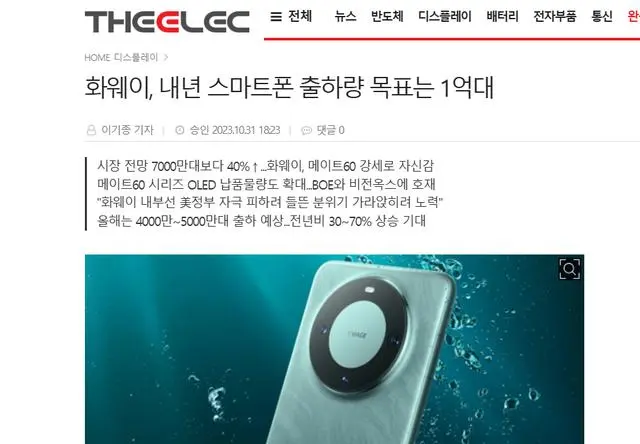Strong demand for the Mate 60 series and other new Huawei smartphones may lead to further increases in shipping targets.
According to industry insiders cited by South Korean media outlet The Elec, Huawei has set its smartphone shipping target for next year at 100 million units, which is 40% higher than the forecasts of several market research companies (70 million units).
By the end of this year, it is expected that the shipment of the Mate 60 series will reach approximately 20 million units. Huawei’s smartphone shipments for the entire year are estimated to be between 40 million and 50 million units, with a potential year-on-year growth of 30% to 70%.
Even though the Mate 60 series has been on sale for two months, it remains in high demand, with reports of limited availability. When reporters from a financial news outlet visited Huawei’s offline stores, they were told, “Currently, the Huawei Mate 60 series is completely out of stock. If you register now, it will take about 2-3 months to have stock available. As for the Mate X5 series with a foldable screen, you will need to wait for at least six months. As for the Mate 60 RS Master Edition, it’s hard to say; even if you prepay a deposit now, there is no exact delivery date.”
It’s worth noting that the Huawei nova 11 SE was also released on October 31st with a starting price of 1999 yuan. On the same day, the Huawei Mate 60 Pro Excellence Edition was listed on platforms such as the Huawei Mall and JD.com with a starting price of 7899 yuan.
In addition to this, the Huawei nova 12 is also a highly anticipated next-generation product. An industry insider previously revealed, “The launch date for the next generation nova phone is also undecided, whether it will be in December this year or January next year.”
OLED Prices Rise in Tandem: Huawei May Be a Key Driver of Consumer Electronics Recovery Next Year
With strong terminal demand, the supply chain’s shipping volumes are naturally on the rise.
This South Korean media report points out that the OLED shipping volumes for the Mate 60 series have recently increased, with two suppliers: BOE and Visionox. Due to recent volume expansion, the production rate of small and medium-sized OLED lines at Visionox has increased.
At the same time, BOE A is leading the rise in OLED prices for domestic smartphones. Currently, the prices of OLED panels for Chinese manufacturers have risen by 4-5 US dollars. Industry insiders expect that after the peak season at the end of the year, prices will drop by 1-2 US dollars, but they will still be 2-3 US dollars higher than the previous low.
It was previously reported that due to the continued strong sales of the Mate 60 series, Huawei has been increasing its orders for flexible LTPO OLED displays, leading to a price increase for domestic flexible OLED panels of up to 10%. “In the context of tight supply of flexible LTPO OLED, Huawei is willing to pay more to obtain more flexible LTPO OLED production capacity, which has triggered this wave of price increases in domestic flexible OLED panels. Currently, the price increase of domestic flexible OLED panels is still in the exploratory stage, and the specific price increases will depend on projects and market conditions, but the general increase is within 10%.”
Zhejiang Securities reported on October 28 that looking at the third-quarter financial data for the electronics industry, the third-quarter operations of various industries have shown some signs of improvement, and the core targets of Q3 related to consumer electronics, such as Lens Technology and Luxshare Precision, have both seen significant improvements in their Q3 revenues, with Crystal Optoelectronics and Goertek Technology showing Q3 revenue growth of 73.57% and 54.40%, respectively.
Analysts believe that as of the current point in time, looking ahead to Q4 and even 2024, Huawei is expected to become a key driver of the recovery in consumer electronics in 2024. Guojin Securities added that the fundamentals of the electronics industry are gradually improving, and positive performance in the third quarter is expected to continue in the fourth quarter. In the medium and long term, AI is expected to empower consumer electronics, bringing new demand for upgrades and benefiting the industry chain.
